VAUXHALL MOVANO_B 2015 Repair Manual
Manufacturer: VAUXHALL, Model Year: 2015, Model line: MOVANO_B, Model: VAUXHALL MOVANO_B 2015Pages: 209, PDF Size: 4.92 MB
Page 61 of 209

Seats, restraints59
ISOFIX size class and seat deviceA - ISO/F3=Forward-facing child restraint system for children of maximum size in the weight class 9 to 18 kg.B - ISO/F2=Forward-facing child restraint system for smaller children in the weight class 9 to 18 kg.B1 - ISO/F2X=Forward-facing child restraint system for smaller children in the weight class 9 to 18 kg.C - ISO/R3=Rear-facing child restraint system for children of maximum size in the weight class up to 18 kg.D - ISO/R2=Rear-facing child restraint system for smaller children in the weight class up to 18 kg.E - ISO/R1=Rear-facing child restraint system for young children in the weight class up to 13 kg.
Page 62 of 209
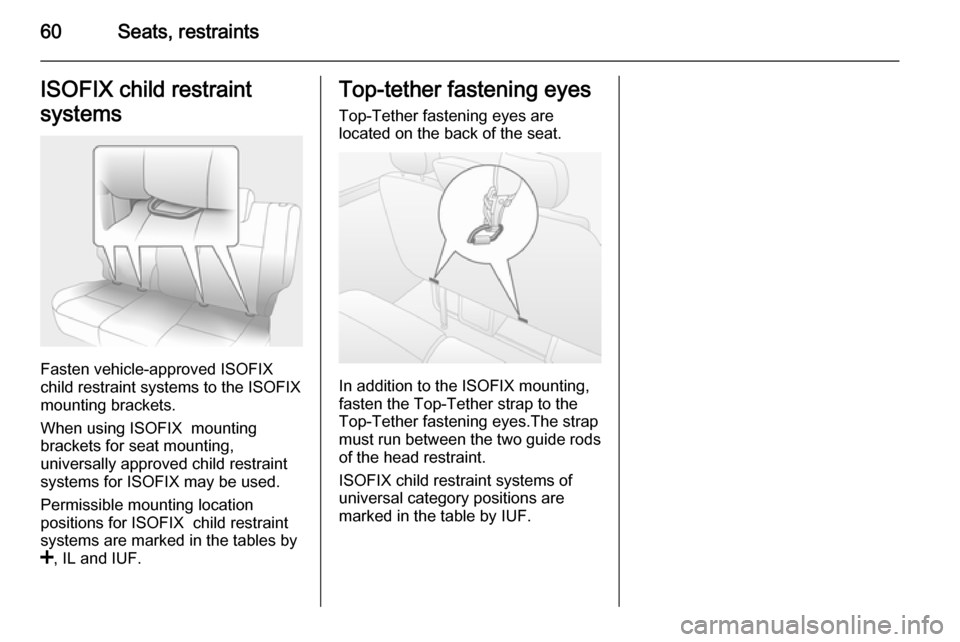
60Seats, restraintsISOFIX child restraint
systems
Fasten vehicle-approved ISOFIX
child restraint systems to the ISOFIX
mounting brackets.
When using ISOFIX mounting
brackets for seat mounting,
universally approved child restraint
systems for ISOFIX may be used.
Permissible mounting location
positions for ISOFIX child restraint
systems are marked in the tables by
< , IL and IUF.
Top-tether fastening eyes
Top-Tether fastening eyes are
located on the back of the seat.
In addition to the ISOFIX mounting,
fasten the Top-Tether strap to the
Top-Tether fastening eyes.The strap must run between the two guide rods of the head restraint.
ISOFIX child restraint systems of
universal category positions are
marked in the table by IUF.
Page 63 of 209
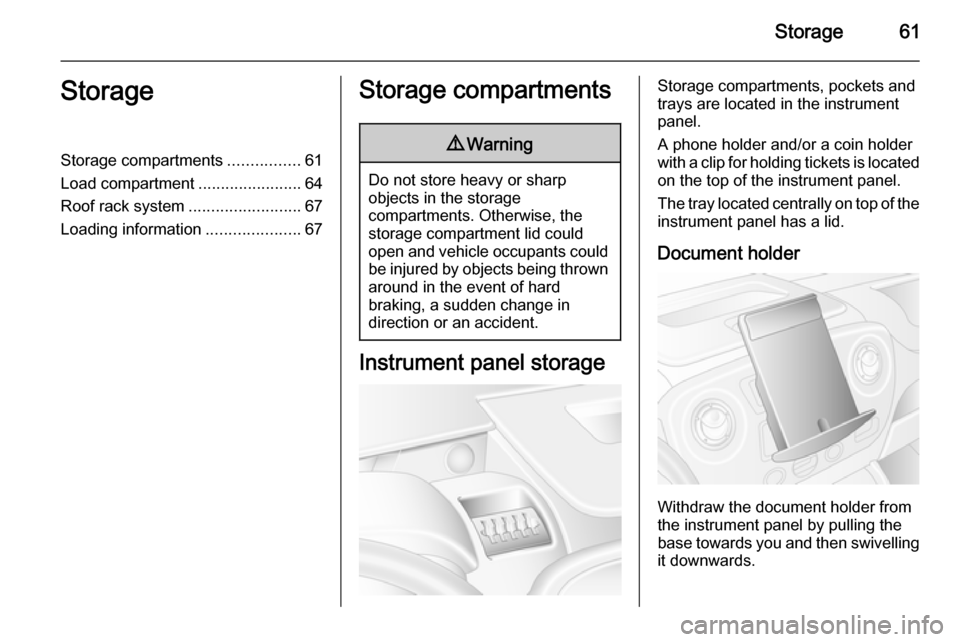
Storage61StorageStorage compartments................61
Load compartment .......................64
Roof rack system .........................67
Loading information .....................67Storage compartments9Warning
Do not store heavy or sharp
objects in the storage
compartments. Otherwise, the
storage compartment lid could
open and vehicle occupants could be injured by objects being thrown
around in the event of hard
braking, a sudden change in
direction or an accident.
Instrument panel storage
Storage compartments, pockets and
trays are located in the instrument
panel.
A phone holder and/or a coin holder
with a clip for holding tickets is located on the top of the instrument panel.
The tray located centrally on top of the instrument panel has a lid.
Document holder
Withdraw the document holder from
the instrument panel by pulling the
base towards you and then swivelling it downwards.
Page 64 of 209
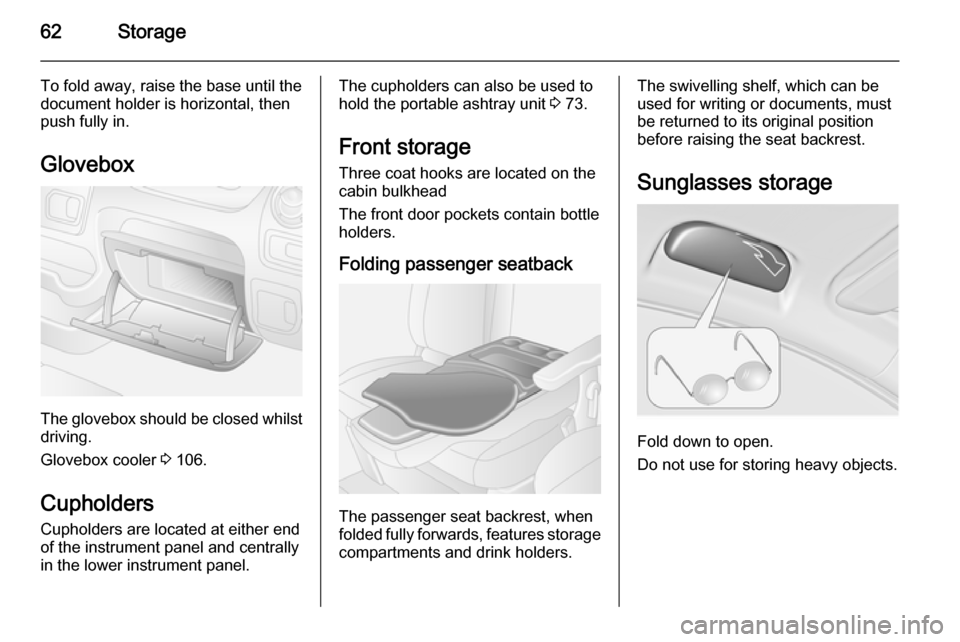
62Storage
To fold away, raise the base until thedocument holder is horizontal, then
push fully in.
Glovebox
The glovebox should be closed whilst driving.
Glovebox cooler 3 106.
Cupholders
Cupholders are located at either end
of the instrument panel and centrally
in the lower instrument panel.
The cupholders can also be used to
hold the portable ashtray unit 3 73.
Front storage
Three coat hooks are located on the
cabin bulkhead
The front door pockets contain bottle
holders.
Folding passenger seatback
The passenger seat backrest, when
folded fully forwards, features storage
compartments and drink holders.
The swivelling shelf, which can be
used for writing or documents, must
be returned to its original position
before raising the seat backrest.
Sunglasses storage
Fold down to open.
Do not use for storing heavy objects.
Page 65 of 209
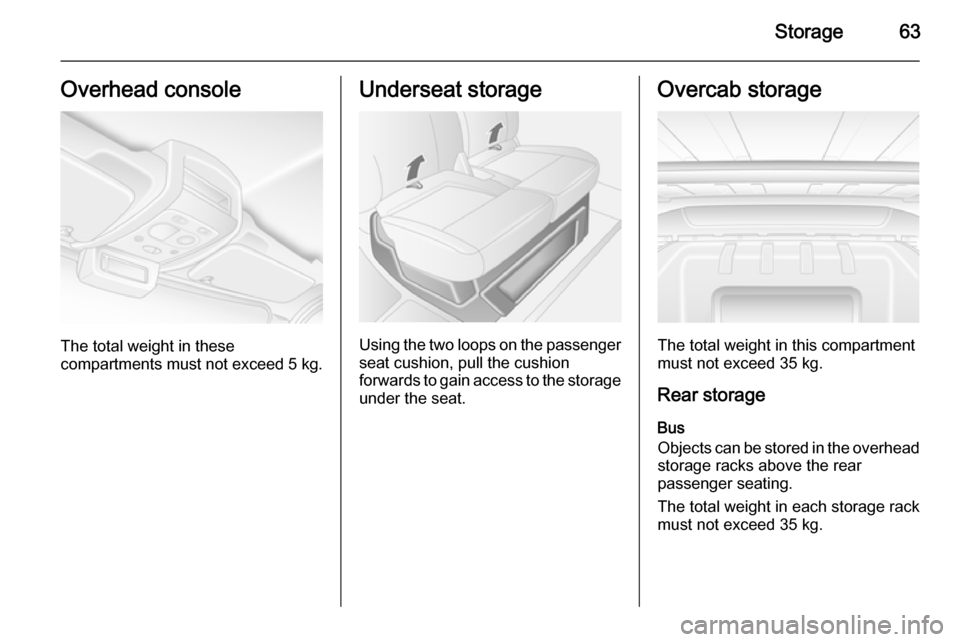
Storage63Overhead console
The total weight in these
compartments must not exceed 5 kg.
Underseat storage
Using the two loops on the passenger
seat cushion, pull the cushion
forwards to gain access to the storage
under the seat.
Overcab storage
The total weight in this compartment
must not exceed 35 kg.
Rear storage Bus
Objects can be stored in the overhead
storage racks above the rear
passenger seating.
The total weight in each storage rack
must not exceed 35 kg.
Page 66 of 209
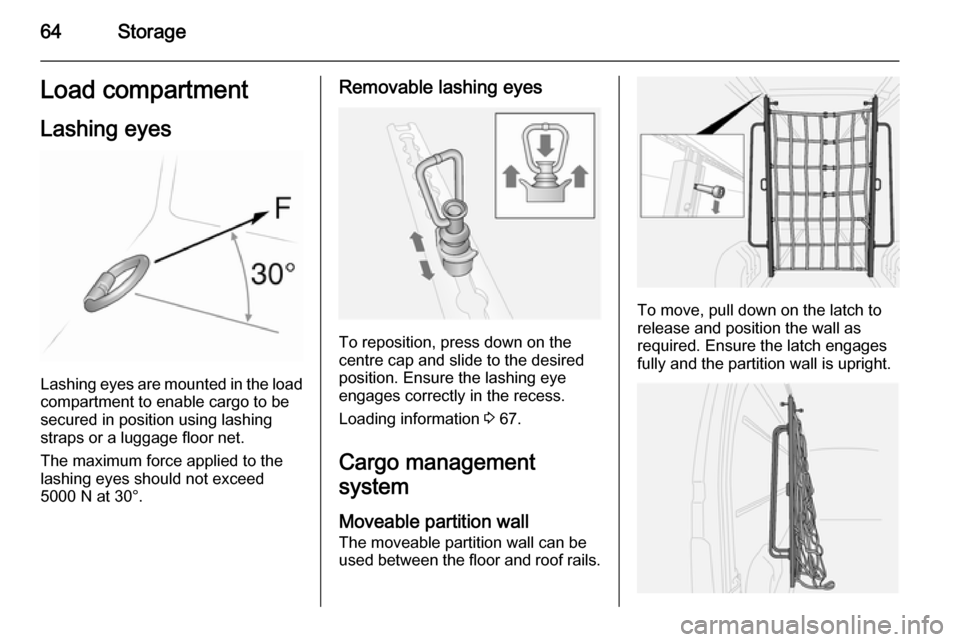
64StorageLoad compartmentLashing eyes
Lashing eyes are mounted in the load
compartment to enable cargo to be secured in position using lashing
straps or a luggage floor net.
The maximum force applied to the
lashing eyes should not exceed
5000 N at 30°.
Removable lashing eyes
To reposition, press down on the
centre cap and slide to the desired position. Ensure the lashing eye
engages correctly in the recess.
Loading information 3 67.
Cargo management
system
Moveable partition wall
The moveable partition wall can be
used between the floor and roof rails.
To move, pull down on the latch to release and position the wall as
required. Ensure the latch engages
fully and the partition wall is upright.
Page 67 of 209
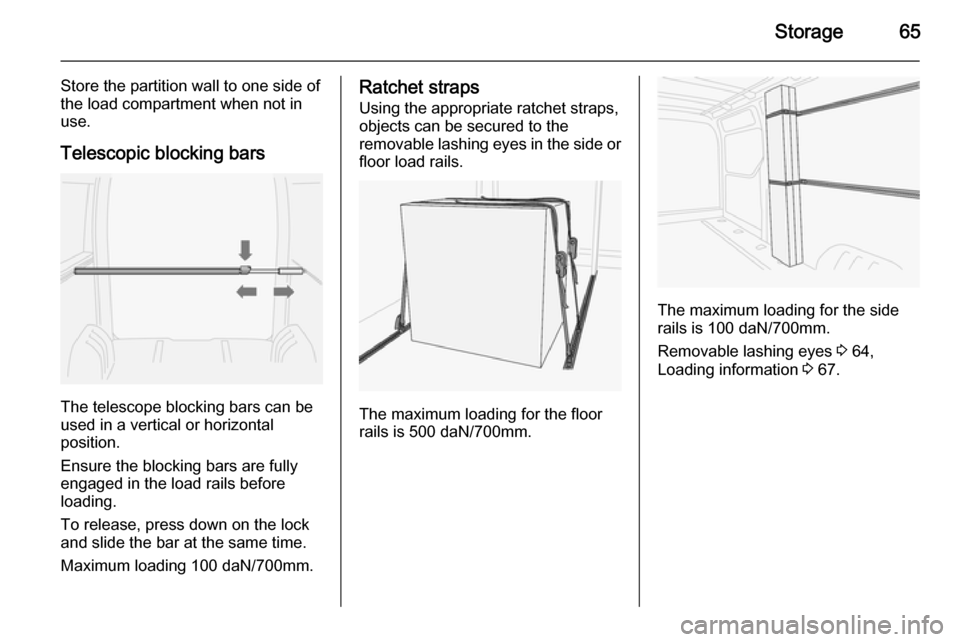
Storage65
Store the partition wall to one side of
the load compartment when not in
use.
Telescopic blocking bars
The telescope blocking bars can be
used in a vertical or horizontal
position.
Ensure the blocking bars are fully
engaged in the load rails before
loading.
To release, press down on the lock
and slide the bar at the same time.
Maximum loading 100 daN/700mm.
Ratchet straps
Using the appropriate ratchet straps,
objects can be secured to the
removable lashing eyes in the side or floor load rails.
The maximum loading for the floor
rails is 500 daN/700mm.
The maximum loading for the side
rails is 100 daN/700mm.
Removable lashing eyes 3 64,
Loading information 3 67.
Page 68 of 209
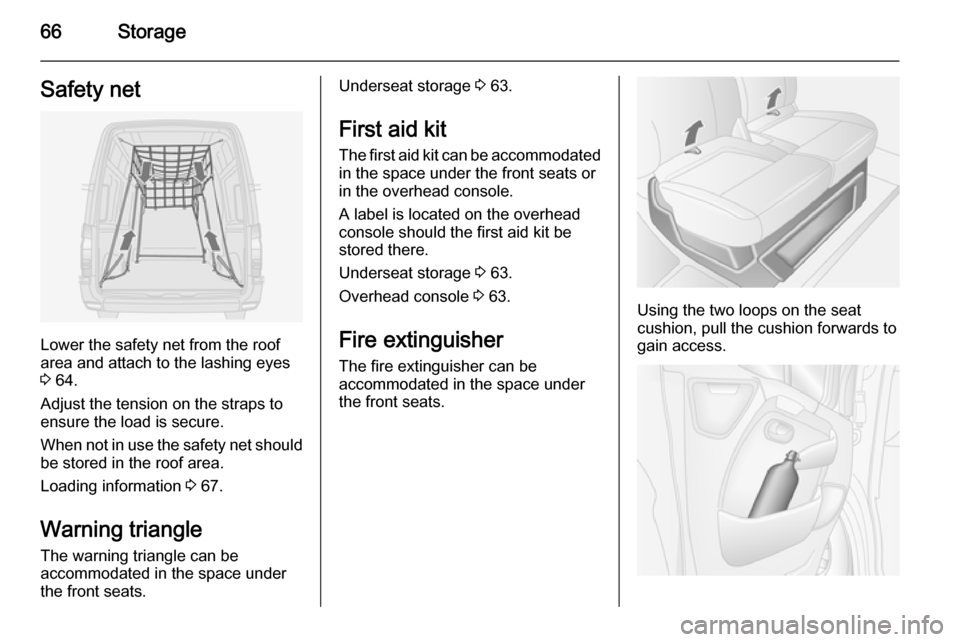
66StorageSafety net
Lower the safety net from the roof
area and attach to the lashing eyes
3 64.
Adjust the tension on the straps to
ensure the load is secure.
When not in use the safety net should be stored in the roof area.
Loading information 3 67.
Warning triangle
The warning triangle can be
accommodated in the space under
the front seats.
Underseat storage 3 63.
First aid kit The first aid kit can be accommodated
in the space under the front seats or
in the overhead console.
A label is located on the overhead
console should the first aid kit be
stored there.
Underseat storage 3 63.
Overhead console 3 63.
Fire extinguisher The fire extinguisher can be
accommodated in the space under
the front seats.
Using the two loops on the seat
cushion, pull the cushion forwards to
gain access.
Page 69 of 209

Storage67
An additional extinguisher may be
located in the front door panel.
As a visible indication of this, a label
is located on the overhead console.Roof rack system
Roof rack For safety reasons and to avoid
damage to the roof, the vehicle
approved roof rack system is
recommended.
Follow the installation instructions
and remove the roof rack when not in use.Loading information
■ Heavy objects in the load compartment should be evenly
distributed and placed as far
forward as possible. If objects can
be stacked, the heavier objects
should be placed at the bottom.
■ Secure objects with lashing straps attached to lashing eyes 3 64.
■ Secure loose objects in load compartment to prevent them from
sliding.
■ The load must not obstruct the operation of the pedals, parking
brake and gear selector lever, or
hinder the freedom of movement of the driver. Do not place any
unsecured objects in the interior.
■ Do not drive with an open load compartment. In addition, the
number plate is only
distinguishable and illuminated
correctly if the doors are closed.
Page 70 of 209

68Storage9Warning
Always make sure that the load in
the vehicle is securely stowed.
Otherwise objects can be thrown
around inside the vehicle and
cause personal injury or damage
to the load or vehicle.
■ The payload is the difference between the permitted gross
vehicle weight (see identification
plate 3 179) and the EC kerb
weight.
To calculate the payload, enter the
data for your vehicle in the Weights
table at the front of this manual.
The EC kerb weight includes
weights for the driver (68 kg),
luggage (7 kg) and all fluids (tank
90% full).
Optional equipment and
accessories increase the kerb
weight.
■ Driving with a roof load increases the sensitivity of the vehicle to
cross-winds and has a detrimental
effect on vehicle handling due to
the vehicle's higher centre of
gravity. Distribute the load evenly
and secure it properly with retaining
straps. Adjust the tyre pressure and vehicle speed according to the load
conditions. Check and retighten the straps frequently.
Do not drive faster than 75 mph.
■ The permissible roof load (which includes the weight of the roof rack)
is 200 kg for standard roof variants.
The roof load is the combined
weight of the roof rack and the load.